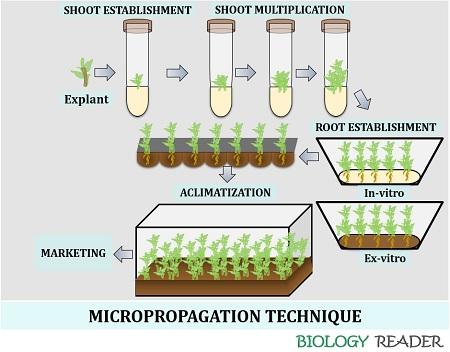The micropropagation technique is an in-vitro plant tissue culture method that can prepare many clones from the small tissue of the stock plant. It is now the most preferred method over the traditional techniques of vegetative propagation. A botanist Frederick Campion Steward first introduced the process of micropropagation.
Micropropagation also gives rise to genetically modified plants by adding desirable traits. Plant propagation generally involves two methods. The sexual method involves the germination of seed. The asexual method involves clone propagation by a multiplication of the vegetative parts in vivo.
Therefore, the micropropagation technique is a kind of in vitro clonal propagation, where an explant proliferates into a number of plantlets under aseptic conditions.
Content: Micropropagation Technique
- Definition of Micropropagation Technique
- Stages of Micropropagation
- Advantages
- Disadvantages
- Conclusion
Definition of Micropropagation Technique
Micropropagation technique is the modern method of tissue culturing that can propagate a large number of new plantlets from a small tissue or explant of the mother plant in the aseptic growth conditions. It was the first plant tissue culture method that has been commercialized and become popular in the field of genetic engineering and crop development. Micropropagation was first used commercially for the preparation of orchid’s clones by a scientist named G. Morel in the year 1960.
Stages of Micropropagation
The micropropagation technique is a complex process, which includes five steps:

Preparatory Phase
It is the initial stage of micropropagation, which involves the selection and culturing of the mother plant. The mother plant should fulfil the following demands:
- The desired mother plant should develop the desired clones.
- It should be disease resistant.
- A mother plant should be pest-free.
- It should be vigorous in growth.
After selection, a mother plant grows for about three months under aseptic controlled growth conditions. During this stage, light and temperature regimes are maintained for the growth of the stock plant.
Establishment of explant into a culture
It is the first and the most crucial stage, where the desired tissue is being selected and cut out from the stock or mother plant. The selection of explant depends upon the objective, like what we want to regenerate.
Example: For the growth of a large number of plants, a small section of a leaf can be taken.
During this stage, an explant goes through several stages:
- Cutting and isolation of an explant
- Surface sterilization by the combination of detergent and bleach.
- Washing with distilled water
- Finally, the establishment of explant on appropriate growth medium for 2-3 months.
A growth media must contain sucrose or other carbon sources to fulfil the energy requirement. Culture media should be supplemented with growth regulators for the culturing of an explant. An explant requires agar-based culture media, which can hold it firmly.
Proliferation and Multiplication of Explant
It is the second stage of micropropagation, where a shoot is cut into several small pieces and subculture into the new growth medium. A shoot then undergoes multiplication for 1-3 steps, where it grows in number as well as size. The proliferation of shoot depends upon the cytokinin to auxin ratio. The propagation of axillary or adventitious shoot needs a high cytokinin to auxin ratio. Cytokinins like kinetic and benzyladenine are commonly used, but their high concentration can stunt the growth of the shoot.
Root Establishment
In this stage, when a shoot attains an appropriate size are then induced for the growth of the adventitious root. For the root establishment, simple micro-cuttings of shoots are transferred to the sterile soil. Root establishment can carry out by either in-vitro or ex-vitro method. Roots develop in ex-vitro conditions, will habituate more easily to normal growing environment conditions than the in-vitro roots. Root development requires an addition of a growth regulator, “Auxin”.
Acclimatization of Plantlets
Acclimatization of in-vitro propagules undergoes washing steps to remove agar. This step involves acclimatising the plantlets obtained from high humidity, low light, and warm environments to normal growing conditions. After that, transfer the hardened seedlings to the sterilized soil under greenhouse environmental conditions for a few weeks. A greenhouse environment maintains the growth or development of plantlets in a controlled environment with more light, low humidity and a ventilated area.
Advantages
A practice of micropropagation involves the following benefits:
- Micropropagation is an alternative method of vegetative propagation where which millions of clones can be prepared by taking the small tissue of the plant.
- It takes less time for the regeneration process.
- A disease-resistant type of plantlet can produce by this method.
- It increases the yield of a plant by providing appropriate growth conditions to the plant.
- Micropropagation needs less space for the propagation of shoots.
- The propagules formed are easy to store and transport.
- A large number of propagules can maintain in the culture vials.
- Micropropagation also maintains the genetic uniformity in the plantlets.
- The proliferation of the explant can carry out in any season of the year.
- This method has successfully commercialized for producing clones of many ornamental flowers, forest, fruit and oil-producing trees, which are economically significant.
- At last, it reduced the quarantine time.
Disadvantages
Micropropagation involves the following advantages:
- Micropropagation is an expensive method to carry out.
- It requires more labour-power with high technical skills for the maintenance of the culture.
Conclusion
A micropropagation method depends upon the choice of explant for proliferation and multiplication. Like for the propagation and proliferation of meristem tissue, we can excise meristem from the apical or axillary shoot of the mother plant. By the method of organogenesis or embryogenesis, we can multiply adventitious meristems and shoot meristem. For the multiplication of callus, we can excise it from any tissue of the plant.